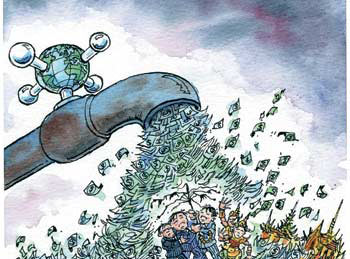Courtesy of The Automatic Earth
 Ambrose Evans-Pritchard's latest article for the Telegraph provides some great data on a theme that TAE readers are quite familiar with – the absence and/or ineffectiveness of the global liquidity faucets that are relied upon to spur growth, inflation, market stability, etc. While it is convenient and understandable that many analysts will argue that central bankers will simply print increasingly large sums of money until monetary velocity accelerates and destroys the value of the underlying currencies, the reality on the ground tells a much different and more nuanced story.
Ambrose Evans-Pritchard's latest article for the Telegraph provides some great data on a theme that TAE readers are quite familiar with – the absence and/or ineffectiveness of the global liquidity faucets that are relied upon to spur growth, inflation, market stability, etc. While it is convenient and understandable that many analysts will argue that central bankers will simply print increasingly large sums of money until monetary velocity accelerates and destroys the value of the underlying currencies, the reality on the ground tells a much different and more nuanced story.
Whether we are talking about QE3 ("sterilized" or otherwise), LTRO1-3, PBoC easing or any other monetary operation, there are a plethora of factors that serve as obstacles to both their occurrence and effectiveness. These factors are economic, financial, social and political in nature. Here is the Evans-Pritchard article that goes back over much of that familiar ground (I have bolded the section which ties in with recent discussion about QE3), and also adds some insightful data points into the mix:
Global liquidity peak spells trouble for late 2012
Data collected by Simon Ward at Henderson Global Investors shows that M1 money supply growth in the big G7 economies and leading E7 emerging powers buckled over the winter.
The gauge – known as six-month real narrow money – peaked at 5.1pc in November. It dropped to 3.6pc in January, and to 2.1pc in February.
This is comparable to falls seen in mid-2008 in the months leading up to the Great Recession, and which caught central banks so badly off guard.
"The speed of the drop-off is worrying. This acts with a six months lag time so we can expect global growth to peak in May. There may be a sharp slowdown in the second half," said Mr Ward.
If so, this may come as a nasty surprise to equity markets betting that America has reached "escape velocity" at long last, that Europe will scrape by with nothing worse than a light recession, and that China is safely rebounding after touching bottom over of the winter.
Stocks usually turn about two months before the real economy peaks, but not always.
Stephen Jen from SLJ Macro Partners said the world economy is weaker than it looks, with monetary stimulus losing traction in the West just as China, India, Brazil, et al, hit the buffers, constrained by inflation and their own credit woes.
"The risk here is that the credit cycles in emerging markets mature and start to deflate just as developed markets struggle with their own deleveraging process. We think 2012 will be a tough year for risk assets," he said.
Monetary data for China is remarkable. Real M1 contracted in January, weaker than post-Lehman. The rate rebounded in February but only to zero.
It is too early to judge whether China really can deflate its property bubble with carefully-calibrated credit curbs, achieving a feat that has eluded very clever officials across the world over the last century.
But bear in mind that China has racked up loan growth of 87pc of GDP over the last five years – according to Fitch study that should be compulsory reading – compared to less than 50pc in Japan leading up to the Nikkei bubble, or in Korea before the 1998 crisis, or in the US before the subprime debacle.
We know from China Iron and Steel Association that steel output has dropped from 2m tonnes a day last year to 1.7m this year – with chilly implications for Vale and Brazil's real, or BHP Billiton and the Aussie dollar.
We know too that R&F Properties in Guangzhou reported a 40pc fall in house sales over the first two months of the year, with a 22pc drop in price. Like others, I am watching the Confucian 'soft landing' with curiosity.
Monetarism is not an exact science. The latest global signal may prove a false alarm. But monetarists have had a good run during the Great Recession, and were quick to spot the turn-around in the US economy in mid-2011.
What they see now is that US money is losing its fizz. Both M1 and M2 have flattened so far this year, and even contracted slightly in recent weeks.
Meanwhile velocity has plunged, with the M2 gauge dropping below 1.6 last week for the first time since records began in 1959 (as shown in the chart from the Federal Reserve Bank of St Louis below).
Nick Bullman from the consultancy CheckRisks said that should give pause for thought. "It's terrifying that markets are rising given what's going on in the real world," he said.




